Bridging the gap between rain jackets and pack covers, rain ponchos leave no seam uncovered when it comes to foul weather. The best rain ponchos are the Swiss Army knives of precipitation protection. Keeping you and your gear dry from head to mid-thigh is reason enough to consider purchasing a poncho, and the fact that many can double as a shelter only sweetens the deal.
We’ve laid out the best rain ponchos below, and have highlighted the versatility of rain ponchos and how they differ from rain jackets. Find the best rain protection for your needs.

Rain ponchos are lurking in forests far and wide…
Quick Answer: What Are the Best Rain Ponchos?
- Sea to Summit Ultra-Sil Nano Tarp Poncho
- Frogg Toggs Poncho
- Six Moon Designs Gatewood Cape
- Zpacks Groundsheet Poncho
- Cedar Tree Packa
- Fjallraven S/F Rain Poncho
- Rumpl NanoLoft Puffy Poncho
- Sea to Summit Tarp Poncho
- Snugpak Patrol Poncho
Rain Ponchos vs. Rain Jackets
Quite simply, the primary difference between a rain poncho and a rain jacket is going to be the fit. Where rain jackets contour to your body as you would expect from any jacket, ponchos take a drape-it-over-everything approach to rain protection. The fit benefits hikers in many ways — to the degree that some of you may be surprised — and of course, there are some drawbacks.
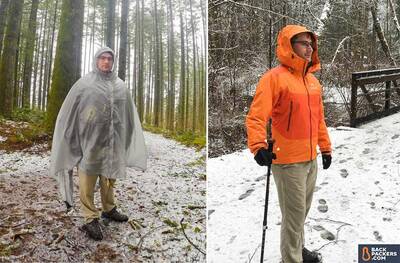
Rain poncho on the left, rain jacket on the right. The difference is striking, no?
Rain Poncho Pros
- Rain ponchos tend to hang lower than your hips (which is where most jackets make their cutoff), and some cover down to your knees.
- Body-length protection from rain
- In most cases saves you from also needing rain pants.
- Ponchos often provide better ventilation than jackets
- The loose fit helps, as does zippered vents (under the arms or down the middle), which rain jackets sometimes have but not always.
- Many poncho models also protect your entire backpack and can be converted into a shelter, providing versatility with which jackets simply cannot compete.
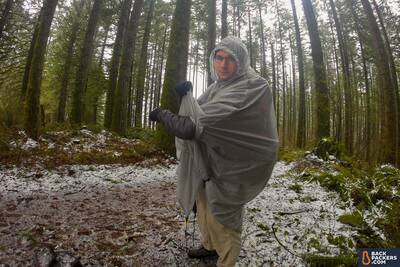
The Six Moon Designs Gatewood Cape offers full coverage, roll-back sleeves, and lots of other ventilation options.
Rain Poncho Cons
- Rain ponchos, when compared to jackets, are typically made from thinner, less durable materials, so keep an eye out for trailside thorns and twigs. This is due to the fast and light idea of a rain poncho, and because if it was made of thicker fabric it would be a much heavier item in your pack, given how much more fabric a poncho has than a jacket.
- If you’re into style — in any way shape or form — a poncho may cramp it. Jackets are form-fitting. Ponchos are not.
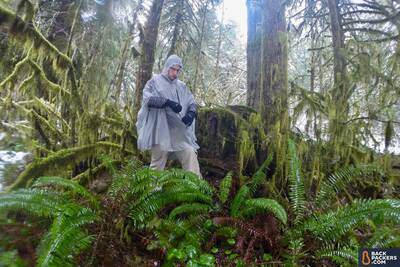
Stylish? We can’t say so. Fully covered? Very.
The 9 Best Rain Ponchos of 2024
Rain Poncho Comparison Table
| Best Rain Ponchos | MSRP | Weight | Shelter | Warranty | See Rain Ponchos |
|---|---|---|---|---|---|
| Sea to Summit Ultra-Sil Nano Tarp Poncho | $119.95 | 8.1 oz | Tarp Tent | Limited Lifetime | See Poncho |
| Frogg Toggs Poncho | $14.99 | 9 oz | N/A | 1 Year | See Poncho |
| Six Moons Design Gatewood Cape | $155 | 10 oz | Tarp Tent | Limited Lifetime | See Poncho |
| Zpacks Groundsheet Poncho | $175 | 5.1 oz | Groundsheet | 2 Year | See Poncho |
| Cedar Tree Packa | $100+ | 15 oz | N/A | At Their Discretion | See Poncho |
| Fjallraven S/F Rain Poncho | $370 | 1 lb. 2.4 oz. | N/A | 1 year | See Poncho |
| Rumpl NanoLoft Puffy Poncho | $149.99 | 32 oz | Warm Jacket | 1 Year | See Poncho |
| Sea to Summit Tarp Poncho | $69.95 | 14 oz | Tarp Tent | Limited Lifetime | See Poncho |
| Snugpak Patrol Poncho | $79.95 | 0.8 lbs | N/A | See Poncho |
The Best Ultralight Waterproof Poncho: Sea to Summit Ultra-Sil Nano Tarp Poncho
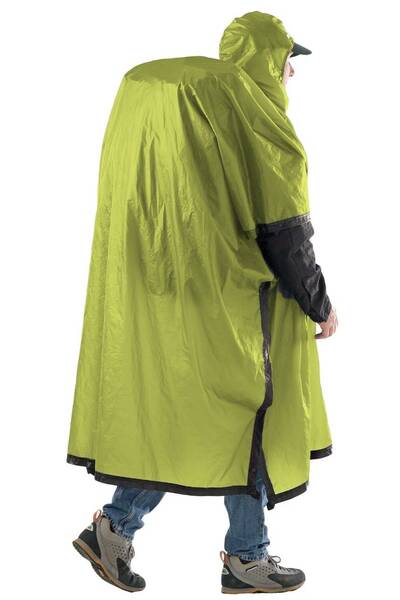
- 8.1 oz
- $119.95
- Best For: Day Hiker, Ultralight Backpacker, Wilderness Backpacker
Introducing the Ultra-Sil Nano Poncho: your all-in-one outdoor essential. Made from waterproof 15D Ultra-Sil Nano fabric, it’s a raincoat, pack cover, groundsheet, and tarp. Easily converts into a 2-person shelter with guy attachment points. Snap together for rain protection, featuring double-stitched, tape-sealed construction and a 3-panel hood. Versatile and ultra-lightweight for any adventure.
See Sea to Summit Ultra-Sil Nano Tarp PonchoThe Best Budget Rain Poncho: Frogg Toggs Poncho
- 9 oz
- $14.99
- Best For: Day Hiker, Ultralight Backpacker, Wilderness Backpacker
The Frog Toggs Poncho is popular for a specific reason: it’s cheap. If you want a halfway decent poncho for about $16, don’t look further than this. It doesn’t do anything fancy, is not made of super durable or strong fabric, and doesn’t transform into something awesome. But for 9 ounces you get a fully functional emergency poncho with hood, which has an adjustment.
It goes to about mid-thigh, is recyclable, and you can always grab another one if it rips (which it might do). The go-to budget poncho.
See Frogg Toggs PonchoThe Most Breathable Rain Poncho and Shelter: Six Moon Designs Gatewood Cape
- 10 oz
- $155
- Best For: Ultralight Backpacker, Wilderness Backpacker
The Gatewood Cape by Six Moons Design is a very unique product. It’s a rain poncho that doubles as a tarp tent. (You read that right!) It weighs just 10 ounces, has a hood for your head, and a large 360-degree coverage when worn as a poncho.
Then, when you get to camp, use your own trekking pole (not included) to set up a very simple shelter. The shelter has a zippered entrance, a floating canopy, an adjustable vestibule height for rain protection, and requires only six stakes. This poncho/tent is kind of ridiculous in its simple ingenuity, and it serves as an excellent emergency piece of kit. You do need to seam seal it, or pay for that, which increases the cost to $155.
Six Moon Designs Gatewood Cape Star Rating
- Comfort
- Durability
- Breathability
- Waterproofness
- Fit
Summary
Replace your rain jacket, tent, and pack cover with the ultralight Six Moon Designs Gatewood Cape. Weighing 10 ounces and packing down to the size of an orange, this do-it-all rain poncho is like a rainy day Transformer.
The Best Lightweight Rain Poncho: Zpacks Groundsheet Poncho
- 5.1 oz
- $175
- Best For: Ultralight Backpacker
The Zpacks Groundsheet Poncho is another dual-purpose poncho. Unlike the Gatewood Cape, this poncho turns into a groundsheet for your tent, which can really equal one of two things: it can serve as extra protection for a tent that already has a bottom, or a bottom to a tarp tent, which normally doesn’t have a bottom.
As a poncho it doesn’t offer total coverage, stopping short at the mid-thigh, but does have a hood, zippers, and a cinch at the waist. It’s made of DFC, which is super durable and naturally waterproof material, so it will help fend off rain from your core. You do need a small pack if you want it to fit over, so we suggest reading the sizing carefully. Overall a decent poncho, but pricey!
See Zpacks Groundsheet PonchoThe The Best Backpacking Poncho: Cedar Tree Packa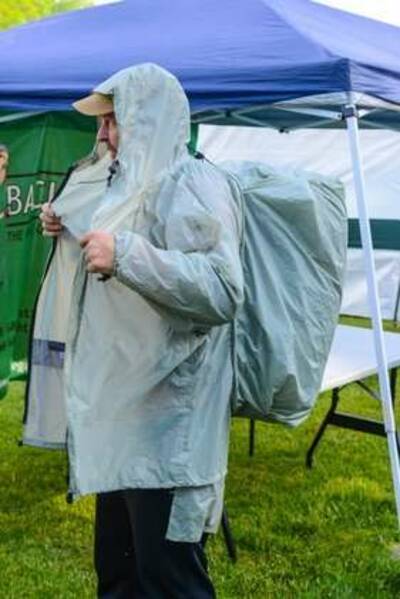
- 15 oz
- $100+
- Best For: Day Hiker, Ultralight Backpacker, Wilderness Backpacker
The Cedar Tree Packa is the most engineered poncho on this list and really aims to replace your rain jacket. The Packa is made to go over your pack, and then, without taking off anything, expand into a poncho that covers your arms, chest, and torso down to mid-thigh. This alone makes it over and above other ponchos, because the main issue with the poncho is how awkward it is to cover yourself AND your pack.
The Packa also has a full zippered front, sleeves that tighten, a fully adjustable hood, and huge pit zips. You can order in different colors and in a few material thicknesses. Note that a single individual makes, ships, and repairs the Packa, so don’t expect a large organization when you get in touch.
See Cedar Tree PackaThe Best For Bikepacking and Urban Rides: Fjallraven S/F Rain Poncho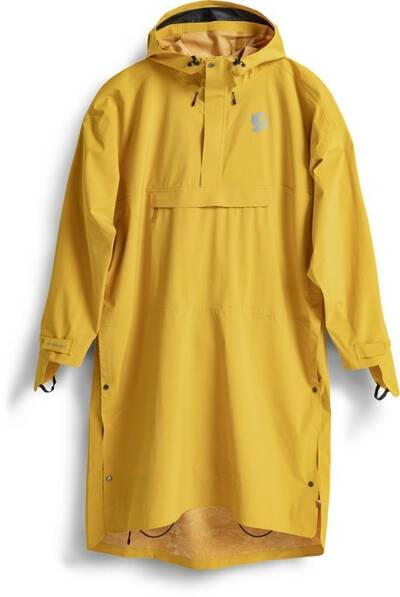
- 1 lb. 2.4 oz.
- $370
- Best For: Day Hiker, Ultralight Backpacker, Wilderness Backpacker
From the Fjallraven/Specialized series, the S/F Rain Poncho is a cyclist’s ally, ready for urban rides and bikepacking escapades. Fully waterproof with taped seams and extendable cuffs, it keeps you dry while remaining breathable and quick-drying.
Adjustable hood fits over helmets, reflective details enhance visibility, and elastic straps ensure a snug fit. Featuring a large kangaroo pocket and convenient packability.
See Fjallraven S/F Rain PonchoThe Warmest Rain Poncho: Rumpl NanoLoft Puffy Poncho
- Weight: Not Listed (32 oz)
- Cost: $249.99
- Best For: Car Camper, Day Hiker, Urban Hiker, Wilderness Backpacker
The same super-cozy NanoLoft technology that Rumpl puts in its puffy blankets has been stuffed into this waterproof poncho. This ultra-insulating down-alternative insulation is perfect for foul weather as it continues to insulate even when it gets wet (unlike down) and dries fast. Being that the poncho is coated in DWR, though, you won’t have to worry about any leaks.
What’s more, this poncho features a fleece-lined snap pouch to keep your phone and other personal items protected, plus it has a hidden drink holder pocket. How neat! Best of all, this poncho packs down into a cozy pillow—so long as you keep it dry. When there’s no rain in the forecast, this Puffy Poncho will work well as a camp Snuggie.
See Rumpl NanoLoft Puffy PonchoThe Best Travel Poncho: Sea to Summit Nylon Tarp Poncho
- 14 oz
- $69.95
- Best For: Day Hiker, Wilderness Backpacker
The Sea to Summit Tarp Poncho covers your body from the rain like a poncho should and also converts into a basic tarp shelter if you really need it to.
It weighs about double what others do on this list, mostly due to the 70D nylon material, which is much thicker. This means it’ll be more durable, which is good for most travelers and day hikers, but not as good for ultralight backpackers. It also accommodates a large backpack and is double-stitched and tape-sealed, indicators of high-quality design.
Sea to Summit also offers this model in a much lighter Ultra-Sil Nano version, but we prefer this Nylon version for general travel as it’s way more durable.
See Sea to Summit Nylon Tarp PonchoThe Best For Hiking, Camping, and Hunting: Snugpak Patrol Poncho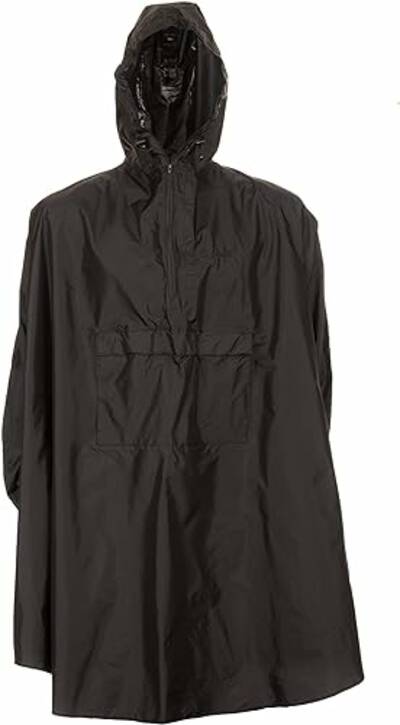
- 12.8 oz.
- $79.95
- Best For: Day Hiker, Ultralight Backpacker, Wilderness Backpacker
Forget scrambling for cover when the skies open up! The Snugpak Patrol Poncho keeps you and your backpack bone-dry on the go thanks to its durable water-repellent coating, then packs down to a travel-friendly 8″ x 4″ size that weighs just 12.8 pounds.
The adjustable hood shields your head, while thumb loops secure the poncho and keep your hands dry. Need to check your map? A handy Velcro pocket with a storm flap keeps it safe and accessible. This versatile poncho isn’t just for emergencies – it’s ready to shield you from the elements in style and comfort.
See Snugpak Patrol PonchoHow to Choose a Rain Poncho
There are several factors worth considering before purchasing a rain poncho. Most ponchos are sold as one-size-fits-all, but that doesn’t mean they are all created equal.
For instance, let’s assume that you’ve made it a habit to hike your neighborhood peak every Saturday morning. This is your favorite day hike for kicking off the weekend and you’re going to do it, rain or shine. All you need is a basic poncho to keep the rain off your shoulders and your daypack. Simple and sleek — the Frogg Toggs Poncho will get the job done.
Now, if you’re more the big-pack backpacker type, you’re going to need a larger poncho with more functionality, perhaps something like The Packa or Sea to Summit Tarp Poncho. These are more durable, more flexible, and have more features, like zippers and vents.
Rain Poncho Size
Don’t let the “one-size-fits-all” idea entice you. Just like different ponchos are tougher than others, you need to think about more than your body when choosing a rain poncho.
To choose the correct poncho size you’ll need to know how big of a pack you’re going to carry. Though purchasing the largest available rain poncho to cover all of your bases is an option, you’ll end up looking (and feeling) like a deflated turtle on those hikes where you decide to leave your big pack at home.
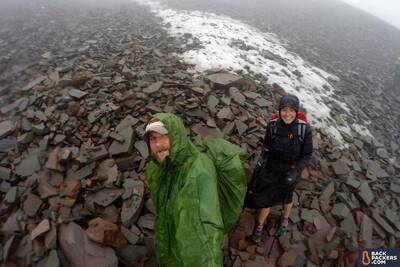
The Cedar Tree Packa is a full-coverage poncho that covers pack, body, and head. It’s great for extended backpacking trips (even entire thru-hikes of the PCT).
On the flip side, you won’t easily fit a 65-liter backpack under the Zpacks Groundsheet without tearing a hole through it. Know the type of rainy excursions you’re going to want a poncho for and choose the size that best fits your needs.
Rain Poncho Zippers, Cords and Pockets
We all know that zippers and cords can make a world of difference in the feel and fit of your gear, and I’d argue that those adjustments are doubly important for rain gear. You’re going to need to strap down your hood, cuffs, and hem tight when the weather gets foul.
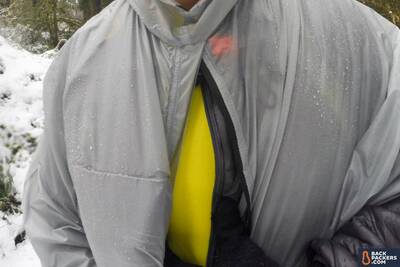
The Gatewood Cape offers ventilation from the front, helping to dump heat when climbing hard.
Finally, don’t forget to check for ventilation options! Any type of rain gear can lead to unwanted perspiration. There’s nothing worse than a self-made poncho sauna that just gets you hot and wet with sweat instead of cold and wet with rain. Some models have pit zips while others rely on the main zipper for ventilation adjustment. The overall openness of ponchos is prone to let in more fresh air than a form-fitting rain jacket, but the sweatier of us will want to look for extra vents.
Pro Tip: Easy access to drinking water and snacks is vital to staying happy in wet weather! Make sure you can still access your pack’s hip belt and water bottles, or choose a poncho that has big pockets.
Rain Ponchos that Convert to Shelters!
This is where the far-reaching rain protection of ponchos leaves jackets in the mud. Beyond protecting you and your backpack from bad weather while hiking, the higher-quality ponchos can be converted into shelters with the help of a few tent stakes and a trekking pole.
The Gatewood Cape and Sea to Summit Tarp ponchos provide 360-degree coverage when staked out as shelters, providing as much protection as would a separate camp tarp. Alternatively, if you prefer to carry a different shelter, the Zpacks Groundsheet Poncho does as its name implies and doubles as a groundsheet for your tent. These dual-purpose ponchos would fit right into an ultralight backpacker’s dream gear list.
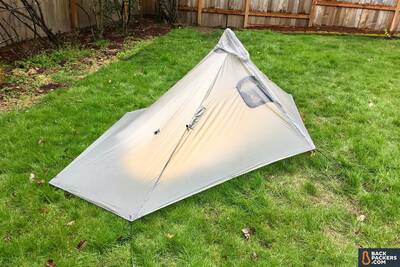
The same Gatewood Cape, now as a tent! It’s a transformer.
How to Buy Rain Ponchos
If you’re looking to grab a poncho instead of a jacket, you’ve already chosen function over form. Ponchos offer excellent rain protection for you and your gear. All that’s left to decide is where your needs fall on the spectrum of function.
We’ve already discussed pack coverage size and shelter versatility — these are your two most important considerations, so make sure you know what you need. After you’ve chosen the general style of poncho you want it’s time to mull over more minor concerns like fabric durability and skirt length. We’ve already listed our favorite rain ponchos at the top of this article to make it easy for you.
Online Retails vs. Retail Stores
Good ponchos are hard to find in physical stores. You’ll be hard-pressed to find anything better than Frogg Toggs at big-box supermarkets, and outdoor stores like REI have a limited selection. Rain ponchos haven’t spiked in popularity yet. Jackets still rule the clothing racks.
Online is your best bet, especially if you’re looking to support a small cottage company like Cedar Tree or Zpacks as they only sell through their own online shops.
The Future is Poncho
As gear companies push ultralight technology to its limits we’re seeing an increase in multi-functional outdoor equipment. Modern rain ponchos are made from extremely lightweight materials. They’re rain jackets, wind jackets, pack covers, shelters, sunscreen, and picnic blankets all in one.
Who knows what they’ll transform into next? Poncho backpacks? Poncho sleeping bags? Poncho trail-runners? That last one might be stretching the imagination a bit, but the others are real possibilities.
For short day hikes, I still prefer a rain jacket, but once I strap on a backpack it’s a poncho or no go. What’s your preference?
Related Content
Backpackers.com Affiliate Policy: This guide contains affiliate links, which help fund our website. When you click on the links to purchase the gear we get a commission, and this goes a long way to creating guides, gear reviews, and other excellent content.
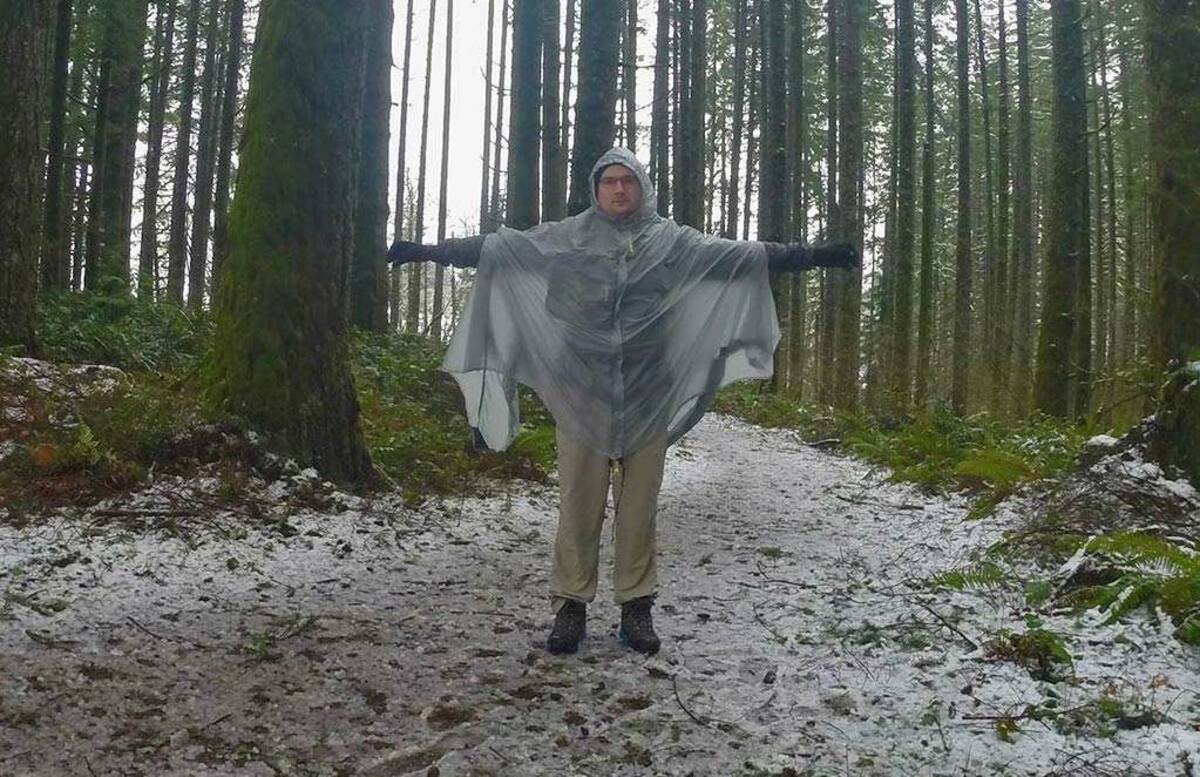
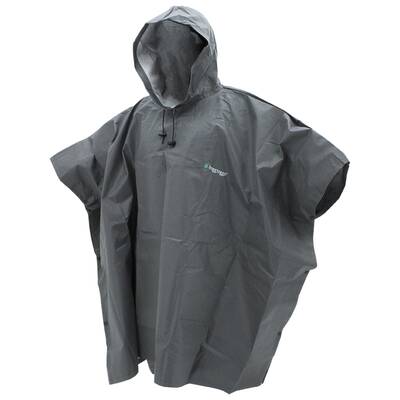
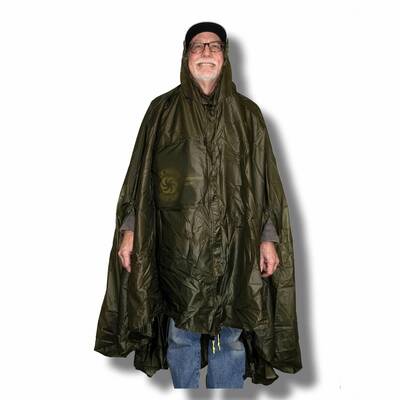
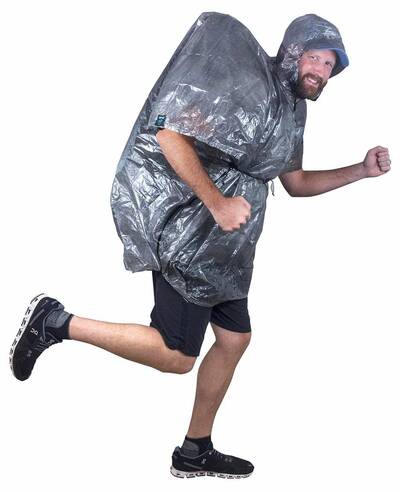
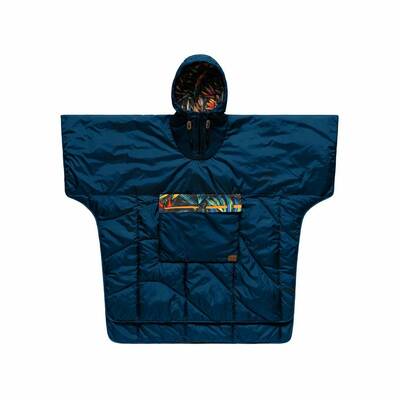
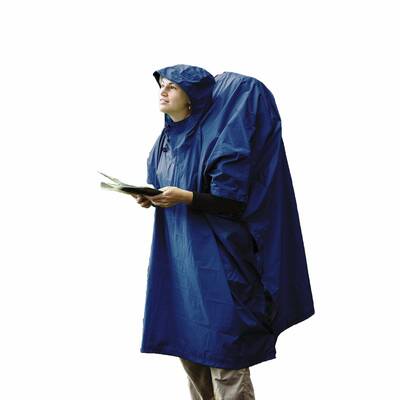
I’ve got the packa, haven’t used it a lot yet and I added snaps to the zipper flap. This way it gives more ventilation as I don’t need to zip it up if it’s calm out. Couple of times I’ve used it, I’m liking it….
I wouldn’t waste my $ on a poncho. However if I did, I see know reason to spend anymore than $5…
My U.S. Military Poncho is so versatile; I’ve used it in all 4 seasons and all kinds of precipitation. I’ve worn it with and without a backpack. A couple of times, I used it with a lightweight blanket as a way to keep dry, warm and sleep. Rain jackets have their place for sure; however, if I can only take one, the jacket stays home.
serious question – how can i get one of those military ponchos? My husband and I have 30 year old ponchos that are dying and struggle to find another long enough (husband 6’2″ and wears it to mid calf). We are in our 60’s so joining the military is out 🙂
Hi Janet! I wanted a second military poncho to match the one issued to me 15 years ago. There are a lot of knock-offs out there. The real one, from my experience, is made by Orc Industries. The best place to find them now are surplus stores. I got my second one from armynavyoutdoors.com. Good luck!
I am ahopping for a poncho because I am often using a walker and since it requires 2 hands and that of course is all I have, I can’t use an umbrella. I’m sure I’m not the only one with this problem but you don’t appear to be aware of it.I will be 79 in a couple of weeks.
Just here to say that you are awesome and an inspiration. Hope you stay dry and keep walkin’!
Thank you.
Canada goose field Poncho does NOT exist. You need to actually do research before posting.
Hi Byn. Yes, it does.
Ponchos are a seasonal item for most retailers and brands, so they tend to go out of stock during the summer.
Thank you for sharing such great thoughts. Very impressive
I wish poncho manufacturers would stop seeing them as one size fits all and reviews would stop praising their “generous length”. As a small woman, it is difficult to find a good one that doesn’t drag on the floor or threaten to trip me.
Outdoor manufacturers: not everyone who enjoys the outdoors is a big tall man!
Cannot find Sierra Designs poncho on their website , or ebay, or Amazon.
Unfortunately it looks to have been discontinued, Scott. We last updated this article earlier this year. It’s time for another update!
I love ponchos and usually have one in my daypack, but another con is that they can get bothersome and unwieldy when the wind is wild. Always good to keep a length of waist sized cordage handy to secure it to your midsection.